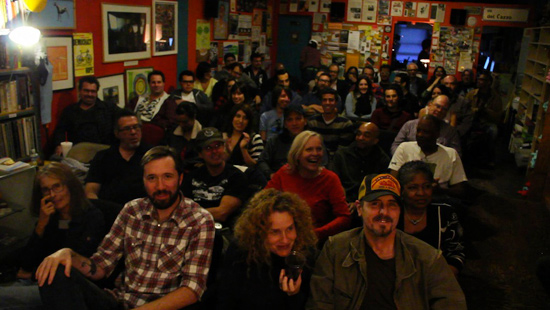When I first started blogging, one of the first people I encountered was Jacques Thelamaque. His blog “A Filmmaker’s Life” had a similar POV as a lot of what I was writing, albeit from a more personal approach. It is always great to encounter a kindred spirit, particularly one who doesn’t seek to just advance their own work, but that of a larger community.
When Jacques later suggested that The Filmmakers’ Alliance wanted to honor my contribution to Indie Film, I was thrilled. It allowed not only he and I to meet, but I also got to see the positive results, and many of the films and filmmakers, that FA helped push forward. The greatest pleasure though was learning how committed Jacques and the FA was to solving the riddle of how best to increase the opportunity and advance the work of the diversity of voices that make up the indie community. Jacques guest blogs today on that vision…
Like Ted, I often look at Independent Film at a macro level seeking trends and ideas that might make my job of supporting it much easier. And from that perspective, it’s not hard to find issues to address – 70 or so of which Ted has eloquently and succinctly delineated. However, that macro perspective does not preclude us from appreciating the micro – the little victories that keep us passionately invested in the success of Independent Film….and ever hopeful. But are those little victories just anomalies with no relationship the “the big picture?” When an indie film is compellingly made and/or earns revenue that benefits its investors, is its success repeatable or always a kind of accident – the result of a numbers game where so many indie films get made that one or two are bound to be well-realized and/or profitable?

The answer is sorta both. For me, it is not a question with a clear answer. And because there isn’t a clear answer, the fact that indie film success is, statistically anyway, unrepeatable becomes a multi-faceted problem with a number of possible solutions. And although people like me will continue to blog relentlessly about it and offer up all kinds of solutions, I believe there is a core concept at the root of this problem and that, for me, is integration – or rather, the lack thereof.
I don’t just mean cultural or ethnic integration, although Independent Film is certainly still principally the domain of the young, privileged, white male. That’s just one manifestation of the issue. Independent film suffers from disintegration and disconnection in nearly every way. Education is disconnected from experience, talent is disconnected from resources, aesthetics are disconnected from technology, filmmakers are disconnected from investors, films are disconnected from their audiences, etc., etc. There’s no irony, then, that a well-realized and successfully distributed indie film is almost always a gorgeous miracle of integration. All the various, sometimes disparate talents and disciplines that make up the filmmaking jigsaw puzzle come together seamlessly to create the film and then the film itself folds nicely into a marketing/distribution/delivery strategy that hits the mark with audiences. It doesn’t happen often, but it happens. And when it does, there are always things to be learned by the process of integration that made success possible.
Now, I realize Independent Film is called Independent Film partly because it can’t be systematized. It pulls itself in many different directions at the same time with a certain cowboy mentality that gives Independent Film its energy and charm. Filmmakers can burst onto the scene from seemingly nowhere using creative or entrepreneurial chutzpah, tearing up the festival circuit before fading away, striking gold in “the system” or becoming revered, if somewhat mysterious, iconoclasts. And the fact that such discoveries are so rare might be part of a necessary cinematic Darwinism, ensuring that the cream always rises to the top. I could accept all of that if there weren’t so many easily correctable issues that could be addressed or if there weren’t so many potentially strong and/or strong-performing films undone by simple ignorance or negligence. Precisely because Independent Film is so disintegrated that it can benefit hugely from a communal trough from which filmmakers can gain what they need. And that communal trough is the internet.
What? The interment? If anything suffers from disintegration, it’s the internet itself. There are so many disparate sites, social networks, tools and apps splattered across the web that before you can figure out how best to use them all, one or more of them are obsolete. Even the mighty Facebook, judging from it’s recent downturn in membership and the example of MySpace, may not be around forever. And, anyway, you can’t make movies on the internet, can you?
Well, first of all, you can indeed make a movie on the web. Not any kind of movie, of course, but that’s beside the point. What’s more important to keep in mind is that not matter what any one site may offer filmmakers, the web is, and will always be, a giant repository of education, information, tools and resources – many of which can greatly enhance the filmmaking process if organized and used intelligently. More than that, it can be a powerful communal gathering point for people sharing a common goal. Especially if that goal is to make and distribute great independent films. But aren’t there currently lots of great sites, tools and apps for filmmakers? Why isn’t it galvanizing and rescuing Independent Film right now? Because it is, of course, missing one key ingredient: integration…along with the three most important elements of successful integration – curation, aggregation,and organization.
I realize none of those terms sounds even the list bit sexy, nor do they seem to have anything to do with the art of filmmaking. But I’ll break it down for you in Part 2 of this post. Suffice it to say, for now, that these elements are not just important for a website or in filmmaking. They are important to anything you want to create for yourself, including all aspects of your life. Obviously, you must always curate – make choices. Then, you must acquire the things you want. Then you must put those things where they do you the most good. It’s a simple formula, but surprisingly ignored all too often in life and art. But, in Part 2, I’ll spell out how it can be applied to the internet and to the benefit of all filmmakers.

Jacques Thelemaque is founder and president of Filmmakers Alliance – a filmmaking support collective in existence since 1993 through which hundreds of films have been made. He also makes films, his own and other people’s, and is not ashamed of any of them.





